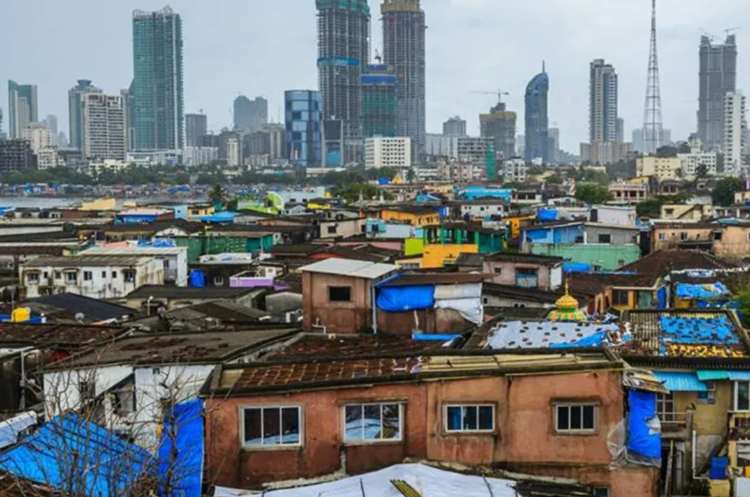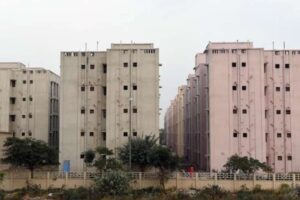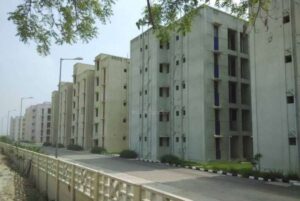
India’s urban housing crisis: Across much of the rich world house prices are an irritant, but in India they have become an existential threat. Europe’s tenants complain that half their incomes go on rent; in Mumbai, that proportion can be 70 per cent for a single windowless room. The OECD’s distress is the prologue. The real drama is unfolding here.
For decades, the salaried middle class could still dream of a starter flat inside city limits. Today that flat has vanished. PropEquity reports that launches priced below ₹ 1 crore in the nine largest metros collapsed from 3.1 lakh units in 2022 to just under two lakh in 2024 — a 36 per cent fall in two years. Hyderabad has lost seven of every 10 affordable units, Mumbai six of ten.
Developers have raced up‑market because land is dear, steel and cement pricier, and banks demand double‑digit returns. In their place mushroom glass‑and‑chrome towers selling for ₹ 3–10 crore, while the median household income in these cities struggles to cross ₹ 25 lakh. Ownership, once a rite of passage, is turning into a lifetime subscription to rent.
READ I How new bike-taxi guidelines can solve the urban mobility crisis
Urban housing supply drought
Economists still debate whether India’s urban housing shortage is 18.8 million units — the official estimate for 2012‑17 — or closer to 30 million if one counts every household living in a slum or an unauthorised colony. Either figure dwarfs annual additions. Launch of affordable urban housing units make up barely 16 per cent of new supply and their share of sales has plummeted from 38 per cent to 18 per cent since 2019. Where inventory exists, it is disappearing fast: unsold stock of sub‑₹ 40 lakh homes shrank by a fifth last year. Consumers are voting with their cheque‑books; the market is simply not providing what they want.

When supply fails, families do not vanish; they move into the 1.08 lakh slums already dotting our cities. There they confront a trifecta of insecurity. First, tenure: one eviction drive can wipe out a lifetime’s savings. Second, basic services: 71 per cent of slums lack underground sewerage, 41 per cent have no toilets. Third, employment: forced relocations to remote resettlement colonies slash incomes by as much as half because commuting costs explode. No OECD tenant faces this lethal cocktail of bad housing, lost livelihood and public‑health hazard rolled into one.
Why the market will not self‑correct
Rising input costs explain only part of the problem. The balance lies in a policy architecture that subsidises the wrong product and discourages the right one. Pradhan Mantri Awas Yojana (Urban) has sanctioned more than 11 million units, yet two‑thirds of its completions are beneficiary‑led self‑construction rather than new urban stock.

The verticals that rely on private developers—affordable urban housing units in partnership and in‑situ slum redevelopment—suffer from slow clearances, land disputes and soaring vacancy rates. Worse, the ₹ 45 lakh price cap for interest subsidies is now hopelessly unrealistic in Delhi, Bengaluru or Pune, so lenders shun the segment and borrowers fail eligibility tests.
The macroeconomic drag
High housing costs erode disposable income, dampen consumption and thus GDP. They also immobilise labour: software engineers in Bengaluru’s periphery spend three hours daily in traffic, robbing firms of productivity.
The World Bank estimates that every 10 kilometre increase in commute distance cuts female labour‑force participation by four percentage points—a silent tax on growth. Add the fiscal burden of ad‑hoc subsidies and the spill‑over into shadow finance, and housing morphs from a social issue into a macroeconomic fault‑line.
A course correction still possible
Rewrite the affordability rule‑book: Price caps and carpet‑area limits must be indexed annually to city‑wise construction indices. A ₹ 60 lakh ceiling in Mumbai might sound outrageous in Patna, but regulation cannot pretend geography is irrelevant.
Unlock land, not just capital: Railway, port‑trust and defence land banks inside city boundaries should be leased on 99‑year terms for mixed‑income projects, with at least 40 per cent of floor space earmarked for units below ₹ 60 lakh. The lease premium can be paid partly by building public rental housing for nurses, teachers and police personnel who now commute from the fringes.
Fund infrastructure, not units: International evidence — from Thailand’s Baan Mankong to Ahmedabad’s Slum Networking — shows that laying pipes and drains and giving secure titles induces households to invest their own savings in walls and roofs. A shift in subsidy from per‑unit grants to per‑hectare infrastructure will crowd in far larger private spending at a fraction of the fiscal cost.
Create a housing credit‑guarantee fund: Bankers fear that loans under ₹ 25 lakh are too risky. A sovereign guarantee on first losses up to five per cent would revive lending to precisely the income bracket now locked out of formal finance.
Revive the rental market: A targeted voucher—paid directly into the landlord’s account once the tenant verifies Aadhaar and rent‑to‑income ratio—can moderate rent spikes while new supply is built. States, not the Centre, should design the voucher value, reflecting local rents.
Europe’s housing squeeze acts as a warning, but its welfare systems and social‑housing cushions offer some relief. India enjoys no such padding. If current trends persist, the nation will enter its demographic peak with a workforce priced out of its own cities—hardly the foundation for becoming a $ 7‑trillion economy.
The lesson from the OECD is not that misery loves company; it is that procrastination carries a compounding penalty. India must treat urban housing as critical economic infrastructure and execute the reforms now, before the crisis crosses the point of no return.
